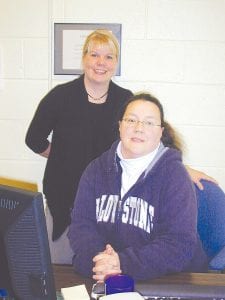Leah Hall (left), Arrowhead Economic Opportunity Agency’s (AEOA’s) housing project manager, and Dawn Byholm, the agency’s Cook County housing project case manager, are eager to help Northlanders with housing problems get back on their feet. AEOA’s new housing program can help people avoid utility shutoffs, prevent eviction, and create workable budgets to keep them in adequate, permanent housing.

Cook County has three viaducts – over Highway 61 in Taconite Harbor – but no stereotypical homeless people are living in cardboard boxes underneath them. Cook County does have homelessness, however.
Sometimes it’s called “couch surfing.” Sometimes it’s described as temporarily sharing living space. It can be called “housing instability” or being “precariously housed.”
Two years ago, the Arrowhead Economic Opportunity Agency (AEOA), in partnership with Hearth Connection and the Northeastern Minnesota Continuum of Care (initiatives to address homelessness), conducted a survey of 64 locals to find out about homelessness in Cook County. Prior to the survey, demographic profiles of Cook County were not showing a need for Minnesota Housing Finance Agency dollars, but the survey helped show otherwise.
The executive summary of the study states that in a request for funding, the agencies described Cook County as “a place of dichotomy – a place of wealth, but also poverty; where affluent outsiders come to vacation; where some put down roots; where some choose to live ‘off-thegrid’; and where the poor and/or homeless might be invisible. …Cook County is far more complex than we knew.”
According to some of the 11 homeless or recently homeless people interviewed, “I know of people that live in tents in the summer and stay at hotels in the winter.” “I know of someone that lives in a shed, another in a camper.” “Many people couch hop.” “When I first moved back I was homeless and lived in a tent.” “I lived with four guys on the beach. I didn’t know where to find help.”
Representatives of government, business, law enforcement, nonprofit agencies, health care, and churches were interviewed, along with some elected officials and the aforementioned survivors of homelessness. They were told: “When we talk about homelessness, we mean living outside, in a car, doubling up or couch-hopping, or living in a place not meant for human habitation. This includes housing without indoor plumbing and/or heating systems and/or camper trailers.
“We realize that in Cook County, some people choose to live ‘off the grid.’ For our purposes, those people do not qualify as homeless because they have the choice to live differently if they wished. People who are ‘off the grid,’ however, without indoor plumbing or heating, who would rather not live that way but haven’t the ability to live differently, do qualify.”
As a result of that survey and with support from the Minnesota Housing Finance Agency’ Family Homeless Prevention and Assistance Program, AEOA has launched a program to help people who do not qualify for help from Cook County Public Health & Human Services but who have housing problems nonetheless.
AEOA has numerous programs, including rehabbing and repairing energy efficiency deficits in homes, but people living in cabins and wanting things like water and septic do not qualify for AEOA’s rehab program because they must already have the infrastructure in place. This new program, launched in January, can help pick up where other programs leave off.
Connecting with the people who could really use help is difficult in Cook County, said Leah Hall, AEOA’s housing project manager. “You don’t have to be the classic ‘homeless’ or ‘living on the system’ to get help,” she said. Some people do have serious or chronic issues such as mental illness or chemical dependency or are living with domestic violence. Many others, however, are simply going through a hard time that is leading them to a housing crisis – perhaps they decided to pay an outstanding medical bill instead of rent or needed to get out of a bad living situation. “By far the majority” of people who are helped by this program have had an isolated crisis or are having a hard time financially and just need help getting back on track, said Hall.
Dawn Byholm is AEOA’s Cook County housing manager. She wears that hat along with a couple of other AEOA hats, providing employment counseling and adult basic education out of a corner office in the west wing of Cook County High School. She can help people avoid eviction or utility shutoffs as well as help them find housing, and she can help connect them with other services to help prevent a housing crisis from happening in the future. “It’s nonintrusive,” she said.
Anyone is welcome to call Byholm to inquire about the housing program for themselves or even anonymously for someone they know. To qualify for services, a person in need must have been denied assistance from the county or need a supplement in addition to what they were granted.
The program can also help people with budgeting. According to Leah Hall, they often have to “get creative” in helping clients figure out how they can survive financially – it’s not just about cutting out unnecessary spending. A client might need to get a better job, get cheaper housing, or get help with childcare.
Byholm can be reached at (218)387- 1134 and is available to meet with people Mondays through Thursdays from approximately 8 a.m. – 11 a.m. and noon to 2 p.m.


Loading Comments